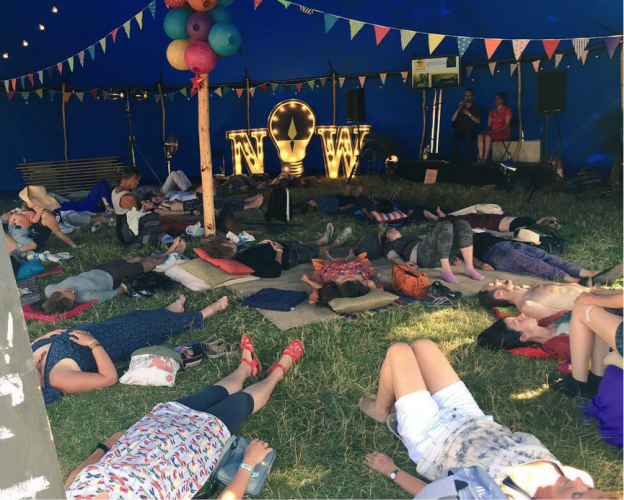Ayesha Nathoo
Over the last year, I have been involved in a number of public events related to my work on the history of therapeutic relaxation. These have included talks, displays and practical workshops at the “Being Human” festival of the humanities, the “Secret Garden Party” and the “Wilderness festival” (in collaboration with Guerilla Science and NOW live events), a “Friday Late Spectacular” and a discussion evening on “Rest and Relaxation in the Modern World” as part of Hubbub, at the Wellcome Collection, London.
The aims, scale, content and audiences varied for each of these events, but together they have left me reappraising my role as a historian, and reflecting on notions of expertise in such public forums. The central topics which comprise my research – ‘rest’, ‘balance’, ‘stress’ and ‘relaxation’ – affect us all, and many audience members were drawn to the events because of pre-existing interests in these matters. Others stumbled across the events by chance with little idea of what to expect or gain from them. In the music festivals, the historical material distinguished my workshops from the myriad other practice-based workshops on offer (such as yoga, mindfulness and massage); elsewhere the practical content differentiated my work from other more traditional academic contributions.
I am particularly interested in understanding relaxation as a taught practice, and the material, audio and visual culture that has furthered its development over the last hundred years in Western, secular, therapeutic contexts. Aural instruction given in classes or on cassettes were key methods for teaching and learning relaxation in the post-war decades and are central to understanding the growth of such practices in both clinical and domestic settings. As well as the instructions, the tone of voice, pace, pauses, and type of medium would have affected how relaxation was understood, distributed and practiced, so I have been keen to track down and share some of the original audio recordings to better understand these experiential and pedagogical aspects. If these have been unavailable I have instead endeavoured to recreate the ways in which different protagonists have taught relaxation, piecing together printed publications, archival material and oral historical resources to do so.
Many of those who participated in the workshops were curious to learn more about the techniques that I discussed – such as yoga, meditation or autogenic training – and their relationship to health and wellbeing. Yet as I was presenting the material primarily as a historian, rather than as a practitioner or advocate of any particular therapeutic practice, some unexpected tensions seemed to arise. Whilst the historical material inspired much interest, most centrally I found that people wanted to evaluate the specific techniques: What was going to work best for them for particular ailments or for general wellbeing? What is the best strategy for alleviating anxiety or chronic pain? Would I recommend relaxation for childbirth? Did I have copies of relaxation instructions that they could take away? Why was I talking about Progressive Muscle Relaxation, one lady asked, when the Alexander Technique (which she had taught for 20 years) was far superior? Was mindfulness meditation really a form of relaxation? Was it best to concentrate on relaxing the mind or the body? What is the evidence base for therapeutic relaxation? Why bother with daily relaxation training if there is a more accessible pharmaceutical option?
Although comparable questions have partly spurred my own interest in this research area, speaking as a historian I have felt uneasy about offering responses. The short, practical, personal questions are not compatible with in-depth answers that address broader medical, social and political contexts, such as the rise of individualism and the mass media, and changes in healthcare, lifestyle and biomedical models. Yet that is what has created and shaped successive demands for and critiques of therapeutic relaxation; contemporary concerns and understandings derive from these past contexts. This is the long and complex narrative that I am researching and whilst I certainly hope that it will have policy implications and be relevant to today’s medical landscape, I do not feel equipped to offer personal advice. Neither am I sure that I should be doing so.
I would speculate that this kind of professional reticence is a majority view amongst historians, and yet it is somewhat frustrating for interested lay audiences. If a professional researcher is investigating a particular subject, then why should they not state their opinions based on the knowledge gained from the research? I have come across this at various other points during past research, on topics ranging from the media coverage of the possible link between autism and the MMR vaccination to organ transplantation and donation. ‘Should I give my child the vaccination?’, mothers repeatedly asked me. ‘Were there any reasons not to sign the organ register?’ ‘Did I think there should be an opt-out clause to increase donation rates?’ It is not that I had not given enough thought to these matters – I had extensively mulled over them – yet I questioned my role as a historian to authoritatively influence other people’s present-day decisions, certainly without allowing the time and space to substantiate my points of view. The aim, however, would not be to give a ‘balanced’ view in the sense of ‘objectively’ presenting a full range of arguments for and against.
The personal is the historical: Knowledge and memories of the past shape views and actions for the future. And so a historian’s personal stance can generally be inferred from their authored work, amongst the layers of interpretations and the selection of sources. Perhaps then scholars should meet the challenge of more explicitly articulating their own views in public contexts, where audience members often lead conversations and set agendas and where the boundaries of expertise are fluid. As ‘public engagement’ becomes an increasingly significant part of academic life, it seems timely and important to open up these discussions.

